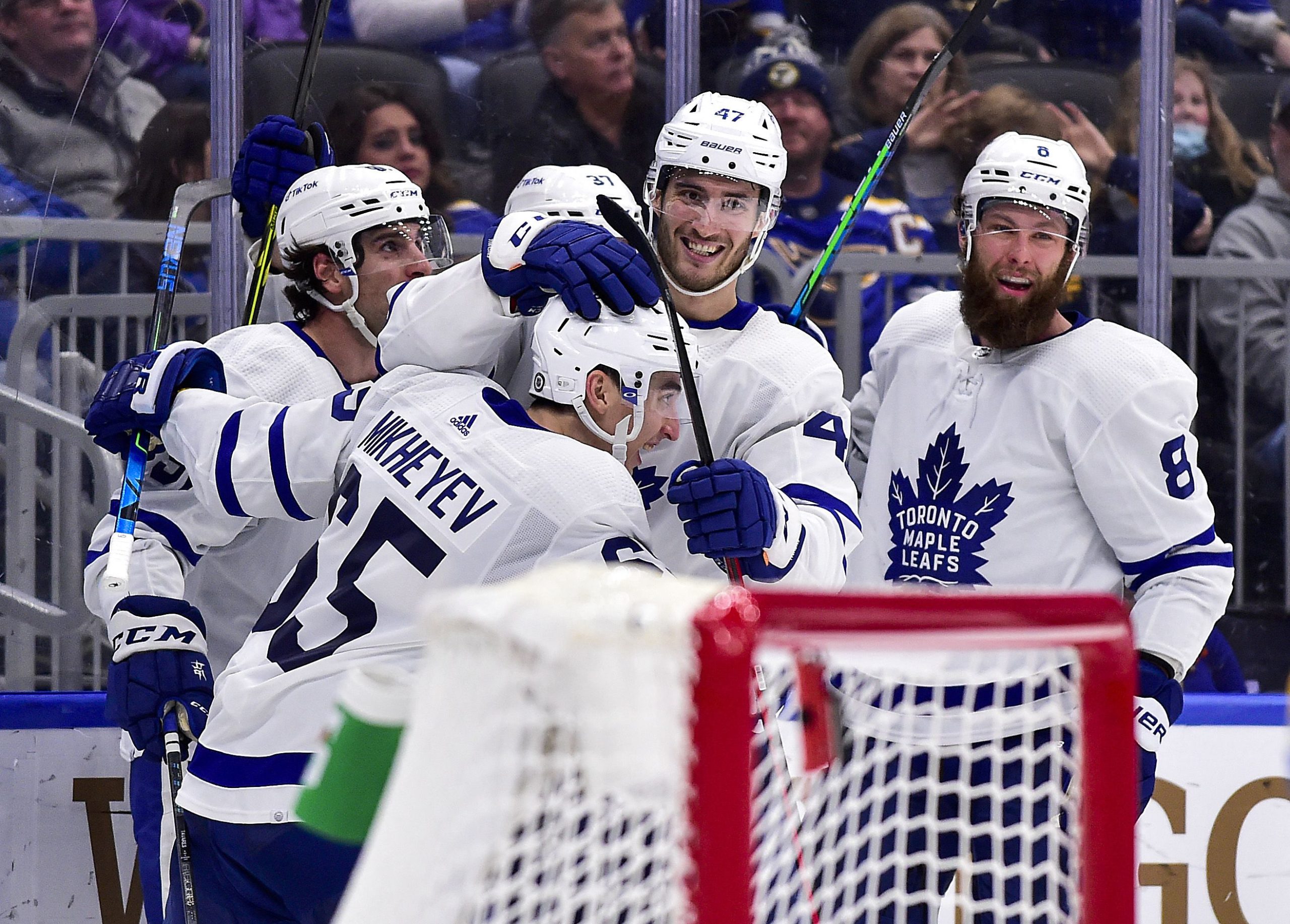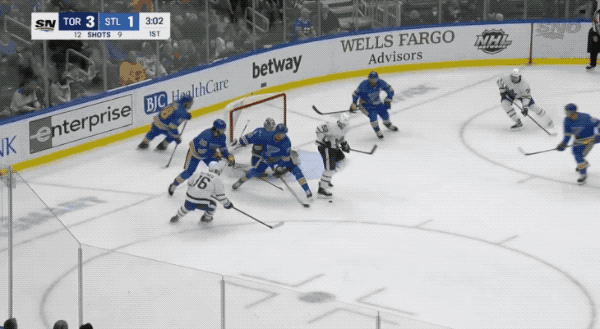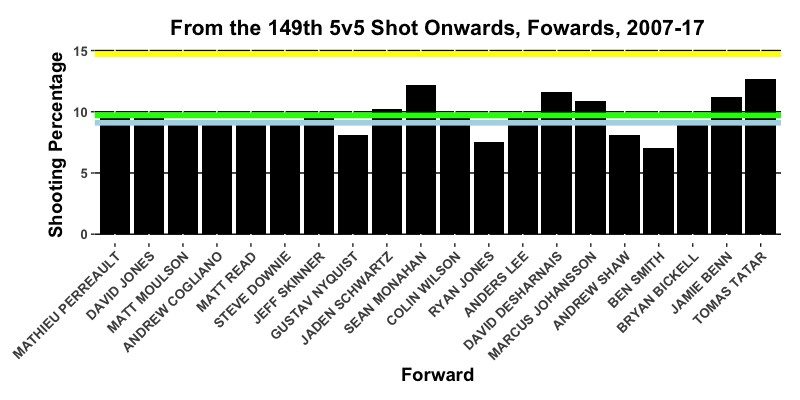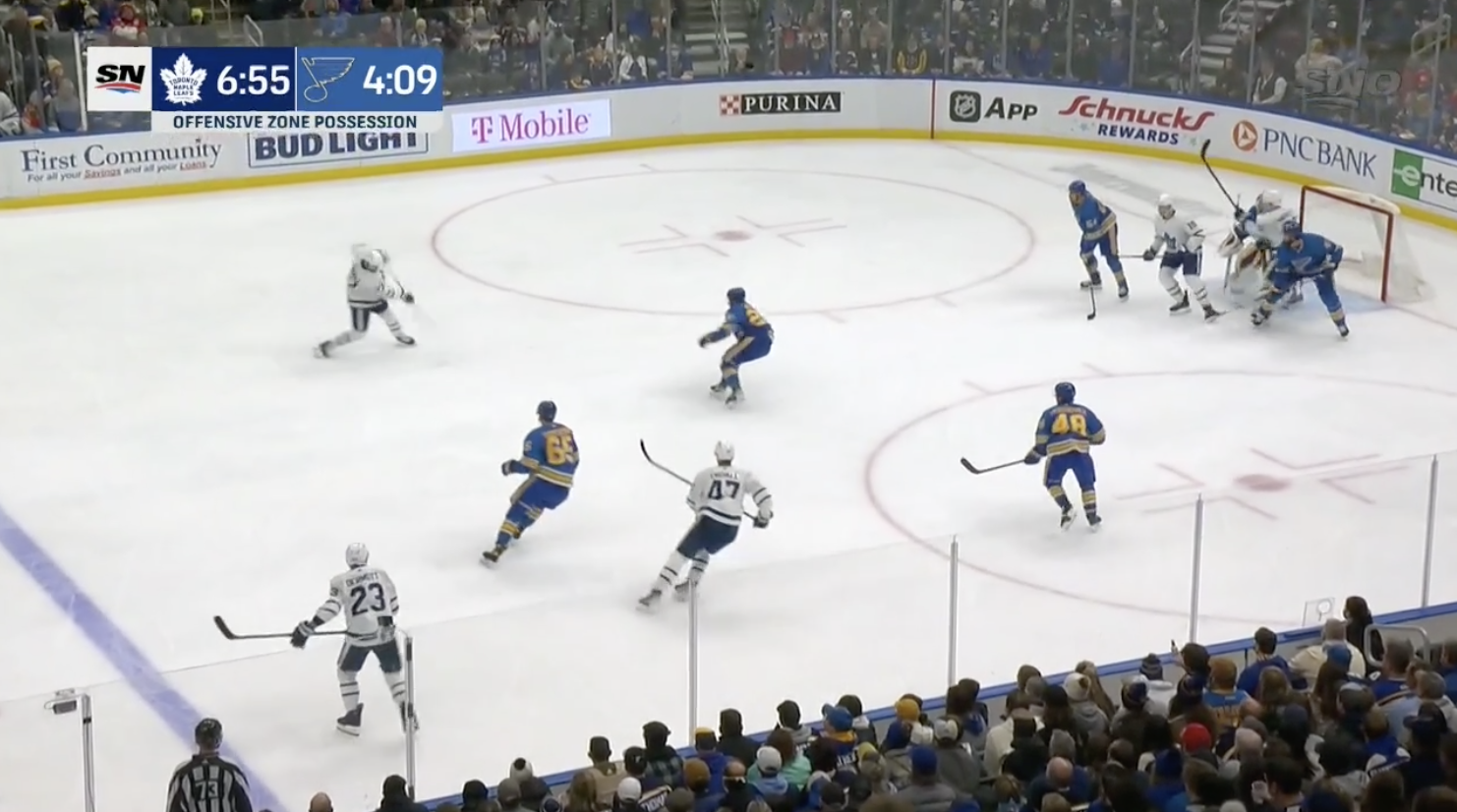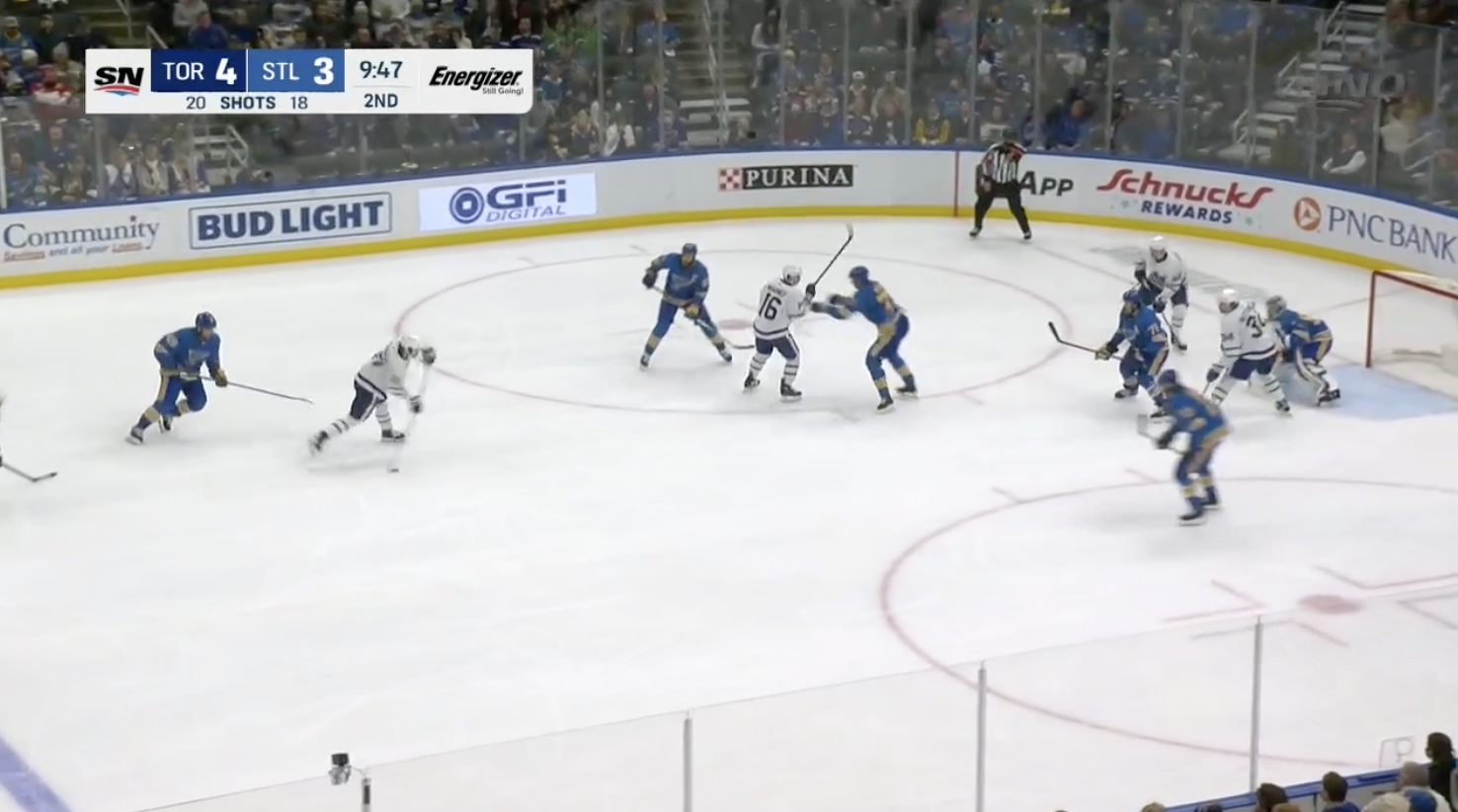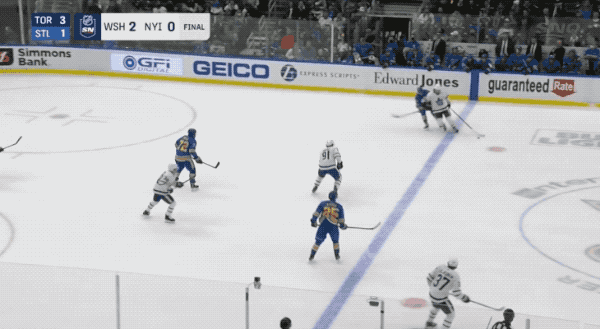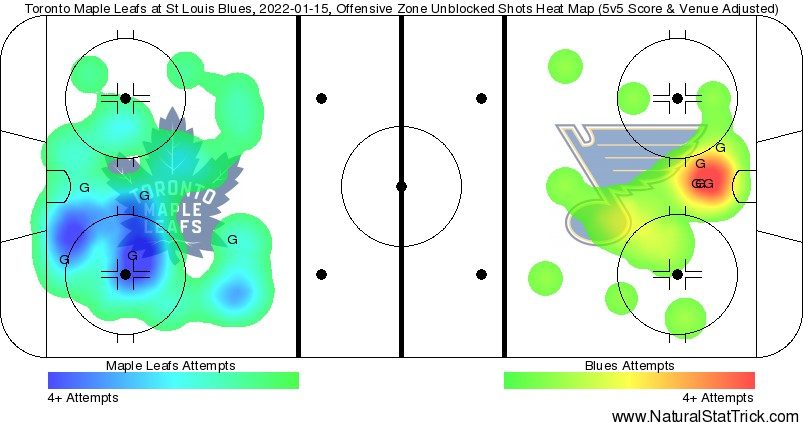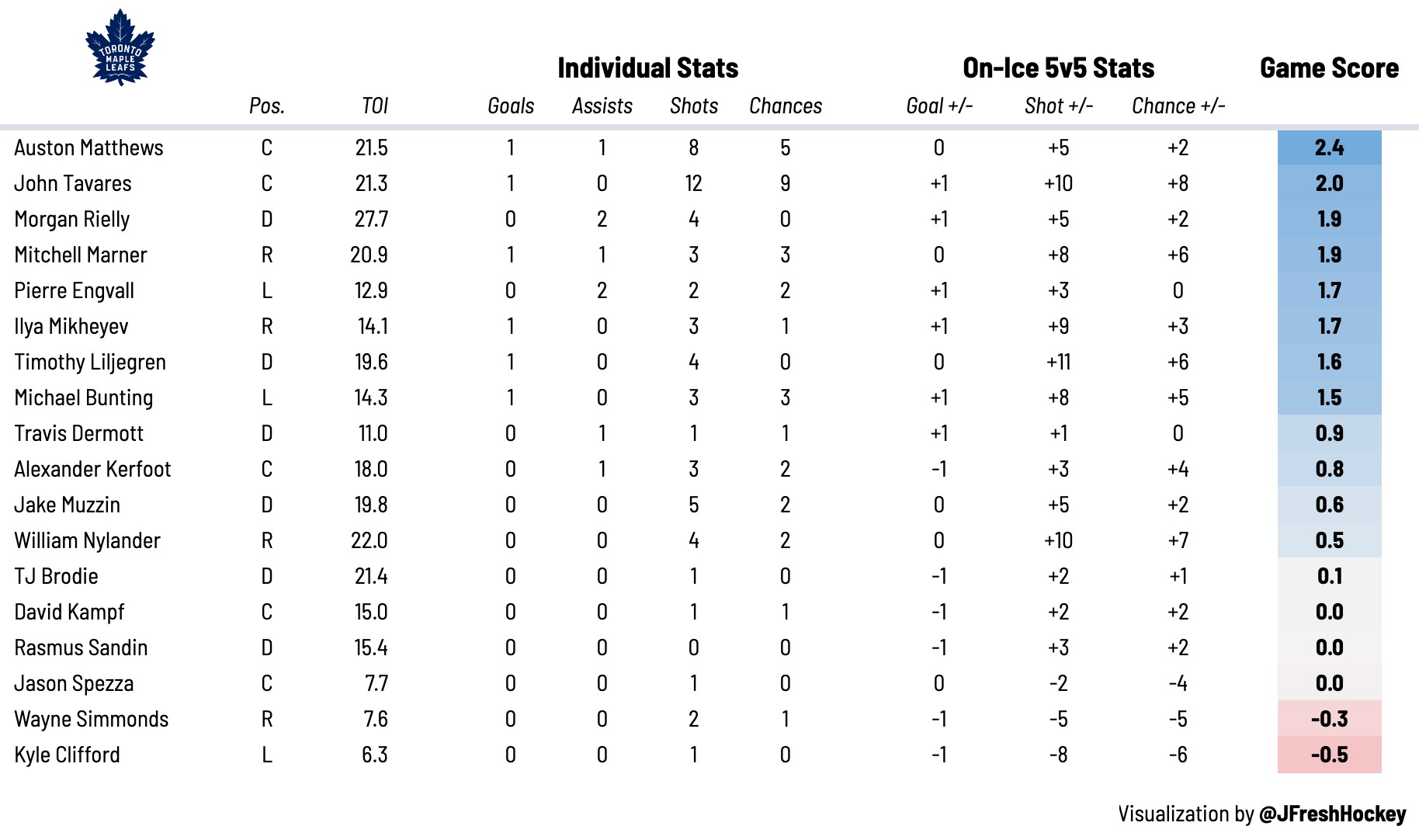Goals galore from Gretzky’s office
If you’re a longtime reader, you already know how obsessed I am with passes originating from behind the net. Research over the last decade has proven that these plays essentially double your expected shooting percentage, which helps explain why The Great One racked up so many assists from below the goal line.
Jordan Kyrou & Co. clearly took a page out of that book last night, beating Jack Campbell on multiple occasions by getting him to move the wrong way post-to-post and quickly convert on passes out front. The Leafs also generated most of their quality looks in that fashion, with Mitch Marner leading the way along with some surprising contributions from Pierre Engvall and Ilya Mikheyev.
As I’m sure you know by now, the final score was 6-5 in a classic back-and-forth momentum-swinging contest. Holding onto leads hasn’t been a problem for Toronto this season until all of a sudden it’s become a consistent storyline this week, with multi-goal leads forfeited in games against Colorado, Vegas, and St. Louis. They still won two of those three games and collected points in all three.
Unfortunately, we’ve grown accustomed to seeing terrible officiating in these games; not necessarily biased — just bad. There was no clear or consistent penalty standard from start to finish for either team, but alas, this will be my last sentence today about refereeing because I’ve grown exhausted with the NHL in this department.
All in all, it definitely wasn’t a game either coaching staff will be super pleased with, although there are significant positives to take out of this game.
It’s time for some Leafs Report Cards!
5 Stars
Mitch Marner (RW, #16) — Right from his first shift, Marner looked like the 95-point player he’s been over the previous three seasons. There’s obviously been a lot of negativity concerning Marner’s play after last year’s playoffs and his 66-point scoring pace coming into this game, but Saturday night gave us a look at why Kyle Dubas and the Leafs‘ brass believe in holding onto star talent.
I could pull up clips of his creativity off the rush, composure with the puck off the cycle, hustle on the backcheck, or his snipe from the high slot. I’ve decided to go in a different direction with respect to my video analysis, although I think we need to acknowledge his wrister beating Jordan Binnington clean from 30 feet out.
“I can score. I can be that threat.” —Mitch Marner, yesterday
— luke fox (@lukefoxjukebox) January 16, 2022
Skating in downhill with speed? Yes. Stationary on the power play? No, and I think everyone in the organization is aware of this, including Marner himself. It’s why the Leafs are always rotating on the power play and interchanging roles. Justin Bourne broke this down in great detail, explaining why Toronto can’t just copy Tampa Bay or Washington’s 5v4 tactics; they need to tailor their system to their star players’ strengths.
A great example of this is the way Toronto uses Marner in the offensive zone at 5v5, bringing him up high in the middle of the ice as an outlet. From there, he uses his passing ability to get his teammates into wide open ice.
Just look at how much room there is for Jake Muzzin to make that east-west pass for an Auston Matthews one-timer. It didn’t go in, but that’s about as high percentage of a play that you can create off the cycle.
Here’s another example of Marner rolling up high in the offensive zone.
There’s so much open space for Morgan Rielly after that give-and-go, it’s essentially a rush chance that Marner manufactured against a set defense.
Every star player has flaws in their game, even the top 10-20 forwards on the planet. Marner is no exception. That said, I think we’re starting to focus too much on the things he can’t do and overlooking the special things he can do with the puck.
Pierre Engvall (RW, #47) — Boy oh boy, did Toronto’s bottom six miss this.
Engvall’s ability to quickly transport the puck from DZ to OZ is such a valuable trait that often goes unappreciated — probably because of those infamous Bad Engvall™ nights. This was a Good Engvall™ night, where he used his speed and puck carrying ability to drive play up the ice with consistency.
It’s been pretty tough to watch Toronto’s third and fourth lines fail to move the puck up the ice with possession, especially through the neutral zone, which is why the re-insertion of Engvall into the lineup made such a noticeable difference to the Leafs‘ transition game.
Although Engvall’s biggest strengths typically show themselves through the neutral zone, he actually made a bunch of great plays in the offensive zone to create quality chances. His no-look pass from behind the net to Mikheyev probably should have resulted in a goal, so the fact that he picked up a pair of assists on basic passes off the wall helps make up for that.
Sometimes you need to be lucky to be good, but it’s no coincidence Toronto’s third line spent the majority of their time in the offensive zone. Engvall was getting them there with his puck-carrying and keeping them there by completing passes off the wall. If anyone wants to join me in the Pierre Engvall Fan Club, we’re still accepting admissions.
Just delete those tweets where you all wanted to waive him not too long ago.
4 Stars
Ilya Mikheyev (LW, #47) — You can’t stop him. You can only hope to contain him.
Leafs' big guns leading the way pic.twitter.com/lwHDM12yNf
— draglikepull (@draglikepull) January 16, 2022
This might be the most hilarious stat I’ve seen this season, albeit in a tiny sample of 84 minutes at 5v5. Do I think Mikheyev is going to keep scoring twice as many goals as Nylander at even strength? No, obviously not, but I also don’t think his conversion rate last year was reflective of his true finishing talent.
As frustrating as it is to watch a player whiff on countless odd-man rushes, it’s also worth remembering they’re pretty volatile year-to-year considering how few breakaways and 2-on-1s you can actually get in any given season. It’s why Michael Grabner scored 27 goals the year after scoring only nine in 80 games for Toronto.
Never trust an uncharacteristically high or low shooting percentage. These things always regress back to the mean, even when you’re convinced the player just sucks at scoring on breakaways.
Michael Bunting (LW, #58) — Funny how we go from talking about shooting percentage to the guy who’s still converting on 13.7 percent of his 102 shots on goal at 5v5 throughout his NHL career. This reminds me of a Tyler Dellow article where he looked at players who scored on over 13 percent of their first ~150 shots on goal at 5v5.
The major takeaway here: they regress to league average.
Yellow Line = First 149 shots
Green Line = Every shot afterwards
Blue Line: NHL average
For those of you who don’t love graphs as much as I do, this study proves that players who shot the lights out in their first 150 shots on goal (averaging 14.9 percent as a group) settled in just a hair above league average the rest of the way.
Research like this is why I try to keep reminding myself that players like Bunting aren’t going to keep scoring on 13 percent of their shots at 5v5, even when my eyes tell me that they’re repeatedly getting great chances from in tight (i.e. his rebound goal off the faceoff on Saturday night).
Just like you, I love Michael Bunting, but the fact of the matter is he isn’t going to keep scoring goals at his current rate. The assists might keep racking up when he plays alongside Matthews-Marner, although Bunting wasn’t completing nearly as many passes off the rush on Saturday night as usual.
Speaking of unsustainable, the penalty drawing wizard might have lost some of his magic.
talk shit (to the bench), get hit. pic.twitter.com/CsTrhKwdEF
— Shayna (@hayyyshayyy) January 16, 2022
Naturally, this resulted in offsetting minors for both players.
John Tavares (C, #91) — The ability to consistently put the puck in the net is clearly a valuable skill, and he’s quietly scoring at a point per game rate this season.
Saturday night against St Louis was a great example of how Tavares can still provide big-time value even if he isn’t necessarily the play-driving force he once was in his prime. Most of his shifts were quiet throughout the game, but when the puck landed on his stick in the slot, he rifled the puck into the top corner on an unscreened NHL goaltender.
Tavares also undressed the NHL’s newest villain, Niko Mikkola, en route to a Grade-A chance off the rush. He also nearly scored on a wraparound. His 200-foot game isn’t what it used to be, but he’s still one of the best forwards in the league at generating chances from the slot (nine tonight) and cashing in on his offensive opportunities (35 points in 35 games).
3 Stars
Timothy Liljegren (RD, #37) — Timoth giveth and Timoth giveth away.
This was both somehow his best and worst game as an NHL defenseman. After scoring his first NHL goal, he played the best hockey of his young career in the offensive zone. He was making confident plays with the puck as it seemed to be following him around, leading to quality opportunities both from Liljegren himself and his teammates thanks to some quick passing from the young Swede.
Defensively, he got victimized by Kyrou a few times. You could complain about an uncalled tackle on the first instance, although Liljegren got away with a tug on Kyrou immediately before that. On the second goal, he just got walked, with Kyrou blowing by him on the right wall to get below the goal line and deliver his second behind-the-net assist of the game.
It was a great example of how young, puck-moving defensemen still need to develop in their own end with respect to positioning and taking away valuable passing lanes. Then again, I still think there are some major positives here.
I’m never a huge fan of defensemen launching pucks from the blue line, but Liljegren got himself into a prime shooting location for his first NHL goal.
A one-timer from that spot with the traffic in front is actually a surprisingly high-percentage shot when you look at the data. It’s why getting to middle ice is such an important part of getting pucks through for defensemen.
On his next shift, Liljegren got a shot off from the exact same location.
It’s obviously not the “ideal” shot for your offense, but by creating a legitimate threat from that area of the ice, it’s going to open up more space for Matthews & Co. to get open off the cycle.
He still has plenty of room to grow, but I’m really liking the progression of Liljegren’s game at age 22.
William Nylander (RW, #88) — With respect to shot selection, I think it’s time to start calling out Nylander for launching low-percentage shots from distance recently. He’s been firing unscreened slap shots from above the top of the circle on the power play a lot lately. Last night on a 6v5 with a delayed penalty, he fired two shots from just inside the blueline, missing the net on the first and ending the possession with the second.
The reason for my frustration here is that we all know Nylander has the talent to make a better play than that. Just look at what he did to St Louis’ entire team at 4-on-4.
He couldn’t get the shot off at the end, but that’s a great example of a skilled player creating something out of nothing. Nylander was making guys miss in the neutral zone all evening, leading to clean entries and plenty of zone time for the Leafs.
Now, some of the frustrations with his effort on the defensive side of the puck came into play in this game. There were multiple instances of him standing flat-footed while his man blew by him for a quality chance in tight, including Mikkola’s goal to put the Blues ahead in the third period.
Alex Kerfoot (LW, #15) — After writing an essay on each player so far, I don’t have too much to say about Kerfoot’s game on Saturday night. It was a tough night to be a 5’10, 180-pound player when the referees decided interference and tackling was allowed. Then again, I was halfway through a sentence about this in Kerfoot’s section when he drew a tripping penalty in the third period.
All hail refereeing consistency. Damn it, I said I wouldn’t bring this up again.
David Kampf (C, #64) — Trying to make notes on Kampf at 5v5 is pretty difficult. He always positions himself above his man in all three zones and rarely has a difference-making moment with the puck, which isn’t necessarily a criticism. He’s paid to not be noticed for 40 seconds and then get off the ice.
The PK is where his game really stands out. The research will tell that once an NHL power play is set up in formation, it’s damn near impossible to prevent them from generating a shot — unless your name is David Kampf. He’s so good at applying pressuring to the opposing power play, forcing the quarterbacks on the half-wall into bad decisions.
Throw in his faceoff prowess — his clean faceoff win secured the win after Morgan Rielly’s puck-over-glass penalty with six seconds left in the game — and you have yourself one of the most valuable 4v5 players in the league. Is now a good time to admit I was dead wrong about the Kampf contract?
The Rielly-Brodie Pairing — They drew the Ryan O’Reilly matchup tonight and did a pretty good job. It was actually Matthews of all people who turned the puck over and lost the ensuing 50-50 puck battle with O’Reilly that led to the 2019 Conn Smythe winner opening the scoring for St Louis.
For the most part, it was a quiet but effective game from both Morgan Rielly and TJ Brodie. The former wasn’t as dynamic as usual offensively, although he was efficient in exiting the defensive zone with possession of the puck. Brodie had a couple of rough turnovers here and there, but he was otherwise solid at defending the rush and making simple passes to his more offensively gifted linemates.
Auston Matthews (C, #34) — Critically evaluating an MVP candidate is tricky. This season, we know Matthews is capable of playing Selke-level defense while producing offense at a 60-goal rate — a truly absurd sentence but it’s true. So when we see him uncharacteristically turn the puck over in the neutral zone and get beat by a great play from another Selke candidate for the 1-0 St. Louis goal, it stands out.
He then scored the game-tying goal with his patented one-timer on the power play and picked up a primary assist on a crafty faceoff win — against one of the league’s best in O’Reilly. Even when he’s not at his absolute best, he’s an absolute game breaker — and still led the team in shots on goal (8) and Game Score.
2 Stars
Jake Muzzin (LD, #8) — It’s probably time to ask whether the 32-year-old coming off injuries in back-to-back playoffs is a top pairing quality defenseman anymore. Typing that sentence hurt my heart, but the evidence is mounting. We’ve seen 35 games of Muzzin getting worse results at 5v5 despite essentially identical linemates and easier competition than his previous two seasons.
I could tell you he had a couple of strong closeouts in the neutral zone along the boards, which is all well and good, but I could also tell you I didn’t trust his pairing at all when the Blues were pressing in the offensive zone. It’s that last part that concerns me the most.
The Sandin-Dermott Pair — I still think back to Dubas’ comments on not having a referendum on a defenseman after one bad goal against, which is fair considering how often we all overanalyze plays where the red light goes off and under-analyze scoring chances that don’t cross the goal line.
That said, I’ve rewatched the following play maybe 50 times and still don’t have a great explanation for why the Leafs allow a 2-on-0 down low.
Sandin cheats for a bit of offense here, but if the puck lands cleanly on his stick, it’s an odd-man rush for Toronto. Instead, he loses the 50-50 puck and it’s a quick odd-man situation against for Toronto.
The inexcusable part is Dermott getting caught puck watching as the last man back. Again, it’s just one play, but it tends to happen a lot with #23. His risk assessment tends to be off in his own end, which is why his coaches don’t trust him on the PK or against the other team’s best players.
Maybe I’m overstating the importance of a small sample here, but it is worth noting this pair barely broke even in their sheltered (and limited) minutes at 5v5.
1 Star
Jack Campbell (G, #36) — Good players have bad games.
It’s such a simple statement but one that rings true with player evaluation, especially with the goaltending position. The broadcast compared Kyrou’s pass from behind the net to Mikko Rantanen’s from last week, both of which caught Campbell leaning the wrong way for goals against.
Now, isn’t this a weakness for all NHL goalies? It’s hard to cover both the threat of a wrap-around to one side and the no-look feed out front to the other side.
There were also some weird goals that took a bounce in the crease and found their way through Campbell’s five-hole. “The Leafs managed to outscore an off-night from Campbell,” is not a statement that’s applied often this season.
The Fourth Line — This is a few games in a row where the fourth line has been a disaster. Jason Spezza isn’t creating anything off the rush, Wayne Simmonds isn’t getting his chances from in tight, and Kyle Clifford isn’t accomplishing much of anything when the puck lands on his stick.
The Leafs might need a shakeup in this department. It’s just a fourth line, but you’d rather outplay your opponents for 10 minutes every night than whatever the heck it is we’ve been watching lately.
Heat Map
Here’s a quick look at where each team’s shots were coming from at even strength, courtesy of Natural Stat Trick.
61 percent of the shots and scoring chances were in Toronto’s favour at 5v5 tonight. It was a crazy game, but one they ultimately deserved to win.
Game Score
Game score is a metric developed by The Athletic’s Dom Luszczyszyn to measure single-game performance. You can read more about it here.
Tweets of the Night
I’m going to try something different tonight. Liljegren going into machine-gun mode tonight made me think about Toronto’s style of play in the offensive zone.
Their defensemen never shoot the puck.
Percentage of 5v5 Shot Attempts Taken by Defencemen – January 15 pic.twitter.com/2TI8gFoeRo
— JFresh (@JFreshHockey) January 15, 2022
Think back to those Marner clips we went through, or scroll back up if you have the time. Those are the kinds of plays Keefe wants his defensemen making; activating down the wall and looking for a higher percentage play through the middle of the ice.
Rather than going into Jakob Chychrun Mode and just launching pucks from the left point, Toronto wants its defensemen to skate themselves into open ice lower in the zone and look for a pass to an open forward.
As a result, the Leafs lead the NHL in shot quality.
Quality per 5v5 Shot Attempt – January 15 pic.twitter.com/D35sqVXP3D
— JFresh (@JFreshHockey) January 15, 2022
This is systemic. Take a look at how often their defensemen were taking point shots last season.
The Leafs have set a clear priority to never take shots for the blueline, opting instead to get themselves to the higher percentage areas of the ice. You could call it Moneyball, Dubaspuck, or just smart shot selection.
It leads to fewer overall attempts for the team, but more quality scoring chances, and by extension, more goals.























